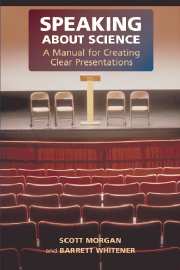Book contents
- Frontmatter
- Contents
- ACKNOWLEDGMENTS
- INTRODUCTION
- 1 THE BASIC PROBLEM WITH ORAL PRESENTATIONS, AND ITS SOLUTION
- 2 THE FIRST STEPS OF PREPARATION
- 3 SELECTING HELPFUL IMAGES
- 4 BEGINNING AND ENDING THE PRESENTATION
- 5 TITLING THE TALK
- AT A GLANCE: THE SEVEN SIGNPOSTS
- AT A GLANCE: 15 KEYS FOR SUCCESS BEHIND THE PODIUM
- IN CLOSING
- APPENDIX 1 FULL INTRODUCTIONS
- APPENDIX 2 POSTERS
- Index
1 - THE BASIC PROBLEM WITH ORAL PRESENTATIONS, AND ITS SOLUTION
Published online by Cambridge University Press: 04 August 2010
- Frontmatter
- Contents
- ACKNOWLEDGMENTS
- INTRODUCTION
- 1 THE BASIC PROBLEM WITH ORAL PRESENTATIONS, AND ITS SOLUTION
- 2 THE FIRST STEPS OF PREPARATION
- 3 SELECTING HELPFUL IMAGES
- 4 BEGINNING AND ENDING THE PRESENTATION
- 5 TITLING THE TALK
- AT A GLANCE: THE SEVEN SIGNPOSTS
- AT A GLANCE: 15 KEYS FOR SUCCESS BEHIND THE PODIUM
- IN CLOSING
- APPENDIX 1 FULL INTRODUCTIONS
- APPENDIX 2 POSTERS
- Index
Summary
Both science and art have to do with ordered complexity.
– Lancelot Law Whyte, in the Griffin (1957)We often ask our students, “What's wrong with scientific talks?” They invariably respond with variations of: They are boring; they are too complicated; they are hard to follow; the speakers have too much information for the time allowed; they do not recognize the different knowledge levels of the audience; they do not look at the audience; they talk too fast or too softly; they sound bored with their work.
Conversely, we are told that good presentations are clear, concise, and focus on a few key points and that good speakers are enthusiastic and help the audience to become engaged. We have seen many accomplished presenters ourselves, and it is truly inspiring to see science communicated well.
Still, as anyone who has taken the podium has discovered, simply telling oneself, “Be clear” or “Be enthusiastic” rarely assures success. It is easy to despair over not being a “born presenter.” Many struggle because they think they are too introverted, are not funny or because English is an alternative language for them. The truth is that there are very few natural presenters, and even they can benefit from technique. One's gregariousness could not matter less in this context; humor is irrelevant to scientific speaking; and nonnative English speakers actually have a few advantages over native English speakers.
- Type
- Chapter
- Information
- Speaking about ScienceA Manual for Creating Clear Presentations, pp. 1 - 8Publisher: Cambridge University PressPrint publication year: 2006



